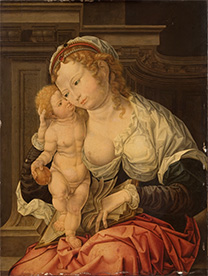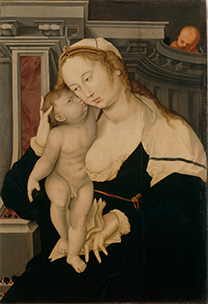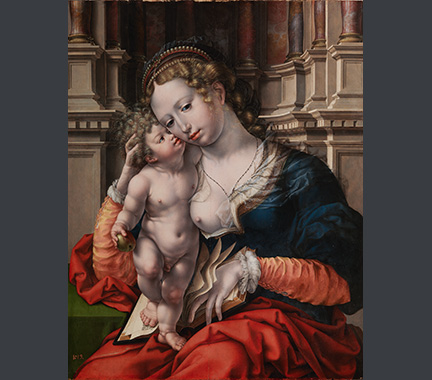Attribution and original function
Attribution
In the Beaucousin collection NG656 was attributed to Gossart; this attribution has never been challenged.10
Original Function


Although the man has not joined his hands in prayer, he has placed his right hand on his heart and holds a rosary in his left hand. He is clearly at his devotions and his gestures may be compared with those of Gossart's unidentified donor on the left wing of a small triptych (Brussels), where the donatrix on the right wing is in a conventional attitude of prayer.11 NG656 is therefore from a triptych or a diptych. The asymmetrical architectural background was probably continued in another panel. At least four versions are known of a ‘Virgin and Child’ which was evidently in the style of Gossart and where the architectural background complements and completes the background of NG656. They are probably copies of the lost left wing of the diptych or triptych of which NG656 formed part. Two of the copies are or were in a private collection in Brussels: one measured 50 x 31.9 cm; the other, attributed to van der Veken, measures 51 x 37 cm.12 Both of these, and another version in Philadelphia (54 x 40 cm: fig.6), seem to be straightforward reduced copies of Gossart's lost original. In all three, the Virgin is dressed in blue, red and purple, though there are slight variations in the colours. The fourth is a variant by Hans Baldung, signed with his monogram HBG and dated 1530 (Nuremberg; 99 x 68 cm: fig.7). Baldung's Virgin is dressed in black, blue and grey.13
Ainsworth objected to the association of the ‘Virgin and Child’ and the London panel on the grounds that ‘the Virgin and Child would be significantly larger than the sitter, whose position would also be far lower’.14 However, it is possible that these distinctions were made deliberately, to emphasise the superior status of the Virgin and Child. Ainsworth also observed that ‘the Virgin and Child appear to be self-contained, not communicating with the supplicant by either pose or glance’.15 It is true that Gossart’s diptychs of Jean Carondelet (Louvre) and Juan de Zuñiga (formerly Barcelona, El Palau) differ in such respects from the proposed reconstruction; but in his reconstructed triptych, where the donor panels in Brussels are united with a ‘Virgin and Child’ in Norfolk, Virginia, the donor ignores the Virgin and Child with determined resolution and they ignore him. They are also on a different scale. In this case, perhaps inappropriately, the donors are much larger than the Virgin and Child, whose throne is only a short distance behind them.16

The figures of the Virgin and Child recur, with a different architectural background, in a painting in the Prado, clearly by Gossart himself (fig.8). The Virgin wears a blue dress and a red mantle but her sleeves are orange-yellow, whereas in the Brussels and Philadelphia pictures they are purplish.17 The Prado ‘Virgin and Child’, which belonged to Philip II of Spain, appears not to be from a diptych.18 The more balanced arrangement of the background architecture and the strong contrasts of colour support the theory that it was designed as an independent image. It is difficult to say whether the Prado ‘Virgin’ was an adaptation by Gossart himself of his lost ‘Virgin’, or vice versa. In either case, the two were probably painted at much the same time.
Further Sections
- Introduction
- Provenance and exhibitions
- Technical notes
- Description
- The identity of the sitter
- Attribution and original function
- Date
11. Friedländer, vol. VIII, no. 6.
12. Collection of Paul Philippot (van der Veken’s grandson): see J. L. Pypaert in Vanwijnsberghe et al. 2008, pp. 278–9 (cat. 306).
13. Weisz 1913, pp. 81–2, was the first to suggest a connection between NG656 and the Virgins in Philadelphia and Nuremberg, which are listed in Friedländer, vol. VIII, Nos. 35a, 35b. For the Brussels Virgin, see Bautier 1925, pp. 91 (fig. IV), 93. All three are discussed and described in detail by von der Osten 1983, pp. 193–4. The Nuremberg Baldung is reproduced in colour and discussed in Löcher et al. 1997, pp. 57–60. Other versions are listed by Ainsworth in Ainsworth et al. 2010, p. 173 note 11.
14. Ainsworth in Ainsworth et al. 2010, p. 281.
15. Ibid.
16. Ainsworth in Ainsworth et al. 2010, pp. 281–5.
17. Friedländer, vol. VIII, No. 35; Ainsworth in Ainsworth et al. 2010, pp. 170–3.
18. Ainsworth in Ainsworth et al. 2010, p. 173 note 1, with the relevant extract from the text of the Escorial inventory of 1584.
